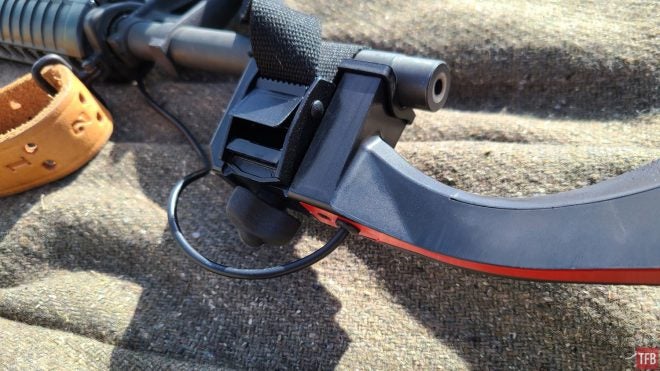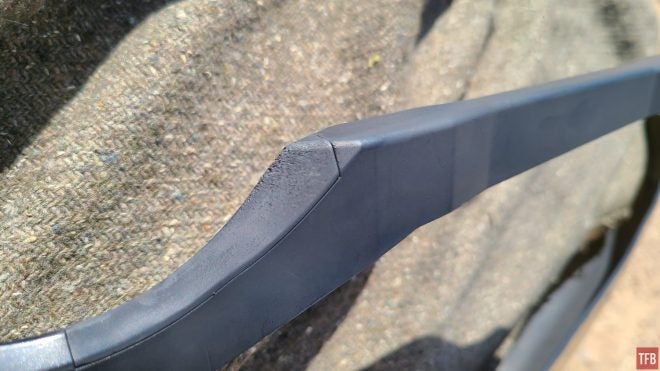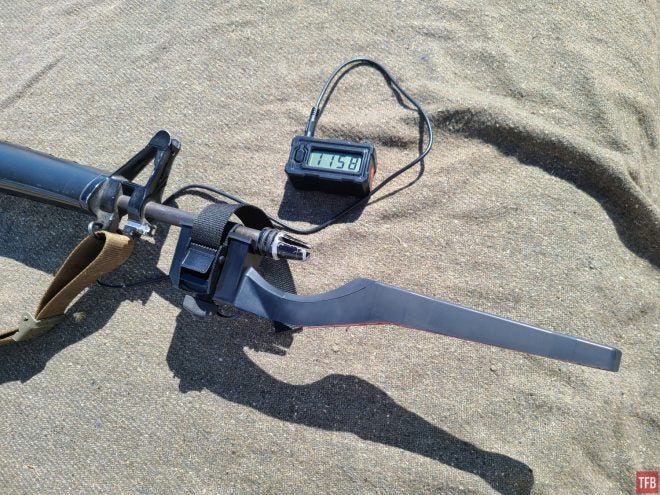For decades, chronographs were a device set up in front of the firing line. That all changed with the introduction of the MagnetoSpeed as they mounted the chronograph to the barrel. So is this change an improvement or not? Let’s find out in this review of the MagnetoSpeed Sporter chronograph.
Chronographs @ TFB:
- TFB Armorer’s Bench: Using The Ballistic Precision Chronograph Kit
- The Rimfire Report: FX Airguns Pocket Chronograph
- DON’T Shoot Saboted Projectiles through Chronographs
- TFB Review: LabRadar Doppler RADAR Chronograph
There are no terms to disclose for this review. I bought this chronograph at a local shop because I needed one for some reloading reviews.
Features
MagnetoSpeed makes two versions of their chronograph, the Sporter and the V3. MagnetoSpeed Sporter retails for around $180 at most stores. The V3 retails for around $400 but includes a more advanced display as well as a full assortment of mounts for different guns. Some of the price savings come from the design of the screen unit. It displays a single line of text and all functions are controlled by one button. The V3 has three buttons for easier navigation.
There are two main pieces to the MagnetoSpeed Sporter – sensor and display. The sensor sits under and in front of the barrel much like a bayonet. A cable extends from the bayonet to the display unit, where the velocity data is displayed. The display runs on a single 9v battery and displays up to four digits at a time. The display unit performs all functions with a single button. Thankfully, MagnetoSpeed includes a detailed laminated guide that explains all of the functions and how to control them. It also lists the various error codes and their meanings so that corrective action can be taken. Plugging the sensor cable into the display turns the display unit on, and unplugging it turns off the unit.

The bayonet and display unit arrive with a rubber band securing them together
The Sporter keeps both its settings and data after it is switched off. Should the unit become unplugged by accident, you will not lose the data from your last string of shots. Any changes to the settings are maintained, for better or worse. I had a whole bunch of errors with my first string of the day thanks to an adjustment to the sensitivity setting weeks before. This was easy to remedy but it did catch me off guard.
One of my only complaints is the nature of the “hard case.” It is two pieces of cheap, thin plastic that slide over one another. Thankfully, the MagnetoSpeed Sporter itself is constructed far better.

This “hard case” is not impressive
The Sporter includes two spacers for fitting the bayonet unit to the barrel. The trick to the MagnetoSpeed concept is the sensor sitting close to the bullet as it leaves the barrel, but not being hit by the bullet. Certain guns may need the thick spacer instead of the thin one to keep enough offset between the bullet and the bayonet.
Setup
Attaching the MagnetoSpeed Sporter is fairly easy, assuming there is enough free barrel space. A piece of webbing feeds through a clamp to set the initial tension around the barrel. Then, the tensioner screw on the bottom of the bayonet cinches the unit tight. Judging how tight is tight enough takes a little practice.
On some setups, like a short-barreled AR-15, there may not be enough space between the front sight tower and the muzzle device to mount the unit. I found that my Mk12-ish gun had just barely enough space between the flash hider and gas block for the MagnetoSpeed Sporter to mount.

The bayonet secures to the barrel with a strap and buckle as well as a tension knob, seen just below the buckle
In Use – Centerfire
Using the MagnetoSpeed Sporter is very easy. You simply plug the sensor into the display and start shooting. The display unit records the velocity for each shot and calculates the average, extreme spread, and standard deviation for that string. As long as the unit is set to the correct sensitivity and is properly secured to the barrel, it will almost always pull good data.
A notepad or notebook should be the constant companion of the MagnetoSpeed Sporter. It does not have any method to export saved data, so the user has to stay on top of writing the data down. This can be a little laborious, especially if the information needs to be entered into a spreadsheet. The V3 model includes an SD card to transfer collected data which would be a valuable addition for serious users.

The high-tech chronograph needs an extremely low-tech pen and paper to record the data from each shot string
Over the course of the review, there was some wear on the bayonet unit. I noticed some light pockmarks on the face of the bayonet facing the muzzle while shooting my Mk12. My best guess is it was caused by unburnt powder hitting the plastic at high speeds. This did not degrade the unit’s function.

Some light damage on the bayonet unit

The MagnetoSpeed Sporter shown on my Mk12-ish rifle
The MagnetoSpeed Sporter works great indoors. Many of the older chronographs struggled to give good data when used inside, usually due to the flickering of fluorescent lights interfering with the sensors. This is not the case for MagnetoSpeed Sporter. The design also works well for indoor ranges because nothing has to be set up downrange. Going in front of the line is a nonstarter at most (or all) indoor ranges, meaning a tripod chrono in front of the firing line cannot be set up. Attaching the chrono to the barrel gets around this logistical hurdle.
Rapid shots do not seem to induce errors in the MagnetoSpeed Sporter. Some older chronographs would struggle if they read shots in too rapid of succession. I tried to shoot the fastest splits I could, and the Sporter kept up with them.
In Use – Rimfire and Silencers
MagnetoSpeed does not advertise the Sporter as compatible with silencers. Their more expensive V3 model does include mounts that work with a silencer. But this made me wonder; could it actually work when attached to a can, even if that was not an advertised feature? Well, dear reader, I tried it out just to see what would happen. As it turns out, it can work!
At first, I struggled to get results. I then removed the spacer so that the sensor would be closer to the projectile, and turned up the sensitivity to Hi 2. Sure enough, I started to consistently get good data. One major caution with this setup is the heat of the silencer. The MagnetoSpeed Sporter is made of plastic and strapping it directly to a hot silencer could be a problem. I was very cautious in my firing schedule and had no problems, but that is not a guarantee of smooth sailing in the future.

The MagnetoSpeed Sporter mounted on a suppressor, which can work in some circumstances
I also used the MagnetoSpeed Sporter on a .22 LR rifle to see if it would work. I found that setting the sensitivity to Hi 1 worked best and produced accurate data. Setting on Hi 2 generated all sorts of errors, and regular sensitivity did not register any information. Playing with the sensitivity for any non-standard use may turn up some good data.

Hi 1 sensitivity provided good results on a .22 LR rifle
Conclusion
All told, I generally like the MagnetoSpeed Sporter. MagnetoSpeed succeeded in creating an affordable and usable chronograph with enough features to get by. Serious reloaders or users who want to gather velocity data from a wide range of guns should opt for the V3. Its SD card data transfer could also be a major time saving for a serious reloader. But if you want a simple way to find out if the velocity number on a box of ammo is good or not, the MagnetoSpeed Sporter will absolutely deliver.
We are committed to finding, researching, and recommending the best products. We earn commissions from purchases you make using the retail links in our product reviews. Learn more about how this works.


